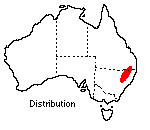Acacia spectabilis
 |
Mudgee Wattle
Acacia spectabilis A.Cunn. ex Benth.
The glorious Mudgee Wattle (Acacia spectabilis) is only one of many fine wattles of garden value and is often chosen because it is ornamental all the year, even when not in flower. It has a silvery grey bloom on its trunk and branches, which wears off lower parts slightly as it ages.
 In
cultivation in a light soil and with good watering it can make a tree 5 m tall
within five years and can exceed this height. In an open position some plants
begin to branch freely near ground level, forming a graceful and spreading head
in which the pale stems show up through the foliage. Other specimens, particularly
when they are crowded near other plants, reach 1.5 m before branching and then
form a slender tree, often leaning, with fewer main branches.
In
cultivation in a light soil and with good watering it can make a tree 5 m tall
within five years and can exceed this height. In an open position some plants
begin to branch freely near ground level, forming a graceful and spreading head
in which the pale stems show up through the foliage. Other specimens, particularly
when they are crowded near other plants, reach 1.5 m before branching and then
form a slender tree, often leaning, with fewer main branches.
It is hardy in frosty areas, but continued drought causes some yellowing and loss of leaves, and adequate water must be given. The graceful pinnate leaves are about 10 cm long, smooth and glaucous, and their grey appearance is enhanced during the Canberra winter. During mid July in a mild season spikes of yellow-green flower buds form, and while waiting to open are almost as ornamental as flowers contrasted against the grey foliage.
A warm spell at the end of August may bring out a few early flowers, but September to October is the main season. The flowers are fairly large balls of good substance and a clear golden yellow - one of the brightest among wattles. The weight of the flowers often bears the branches down. A light scent is noticeable when the tree is in flower. After flowering it is generally hung with seed pods which have a purplish bloom.
Nurseries dealing in native plants may stock this species. However, care should be taken to select one which is not pot bound or checked in any way. Maltreatment will show in a yellowing of the leaves.
Any neutral or acid soil is suitable and an open position allows the head of the tree to develop fully. For several years it will respond to pruning to shape the tree as desired, so that if a shade tree is wanted it may be kept to one leader before being allowed to branch out at several metres high. Light pruning after flowering will lead to a more bushy growth, though regrowth would not follow cutting into older wood.
Based on text by ANBG staff (1972)
Name meaning: Acacia spectabilisAcacia - may be from the Greek to sharpen, alluding to the prickliness of the first species discovered; another opinion refers to the Egyptian thorn (akakia), a species of Acacia which yields gum arabic; spectabilis - showy |
![An Australian Government Initiative [logo]](/images/austgovt_brown_90px.gif)

